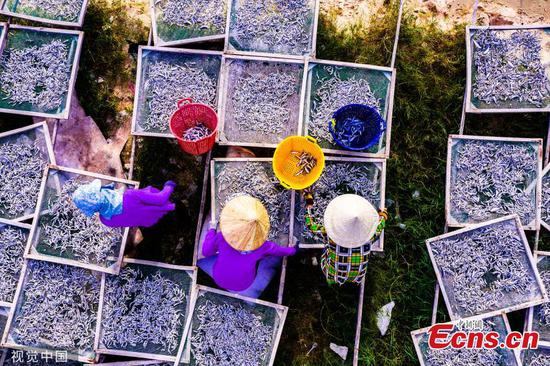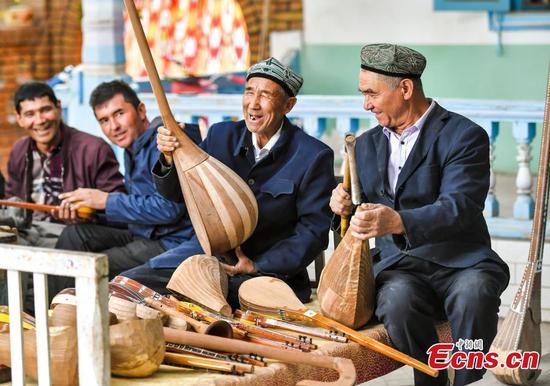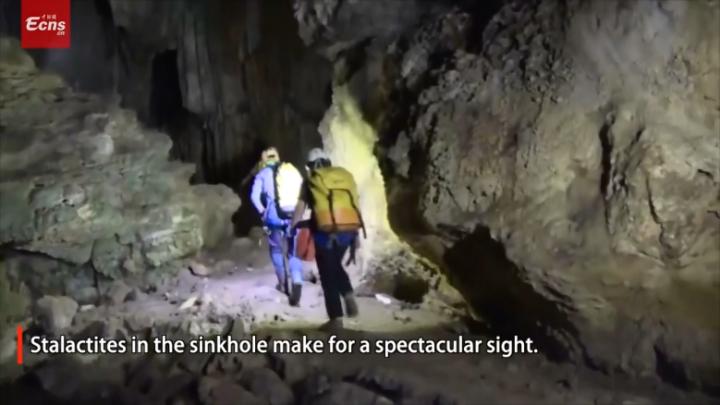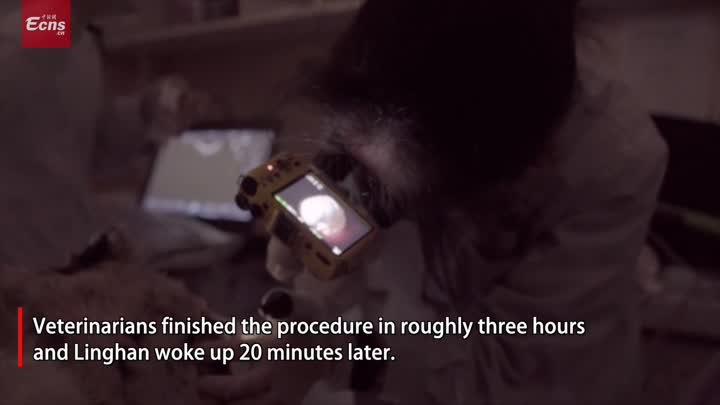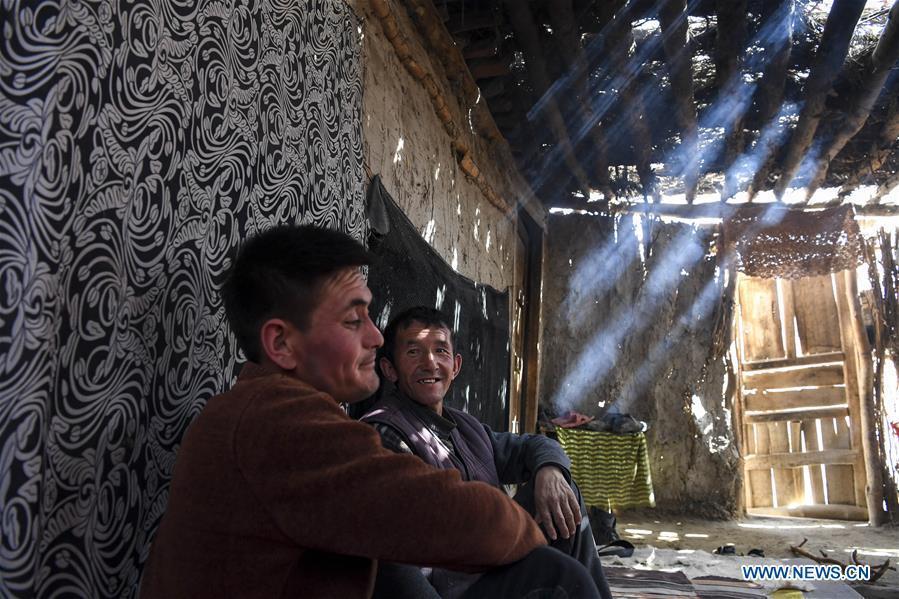
Imin talks with his relative at home in Darya Boyi Town in Yutian County, northwest China's Xinjiang Uygur Autonomous Region, March 16, 2019. Before moving to the new settlement on Nov. 17 and Nov. 18 this year, sheep herder Imin's home was at the heart of the Taklimakan Desert, the second-largest shifting sand desert in the world. For hundreds of years, Imin's ancestors have settled along the Keriya River, which flows from south to north into the heart of endless sand dunes, branching out like fingers and providing the source of water for human habitats. Though the Keriya River has provided for the survival of Imin's ancestors, the environment has become less hospitable, with falling underground water level and frequent sand storms. A resettlement plan is underway to move the residents south to the edge of the desert, where better housing, drinking water facilities and roads are built. The Yutian County government, which administers the town, started to draft plans for resettlement in 2016. So far all of the 216 poverty-stricken households, including Imin's family, have moved into the new settlement, about 110 km from the old town. (Xinhua/Hu Huhu)

Aerial photo taken on Nov. 19, 2019 shows the hospital at relocation area for Darya Boyi Town in Yutian County, northwest China's Xinjiang Uygur Autonomous Region. Before moving to the new settlement on Nov. 17 and Nov. 18 this year, sheep herder Imin's home was at the heart of the Taklimakan Desert, the second-largest shifting sand desert in the world. For hundreds of years, Imin's ancestors have settled along the Keriya River, which flows from south to north into the heart of endless sand dunes, branching out like fingers and providing the source of water for human habitats. Though the Keriya River has provided for the survival of Imin's ancestors, the environment has become less hospitable, with falling underground water level and frequent sand storms. A resettlement plan is underway to move the residents south to the edge of the desert, where better housing, drinking water facilities and roads are built. The Yutian County government, which administers the town, started to draft plans for resettlement in 2016. So far all of the 216 poverty-stricken households, including Imin's family, have moved into the new settlement, about 110 km from the old town. (Xinhua/Shen Bohan)
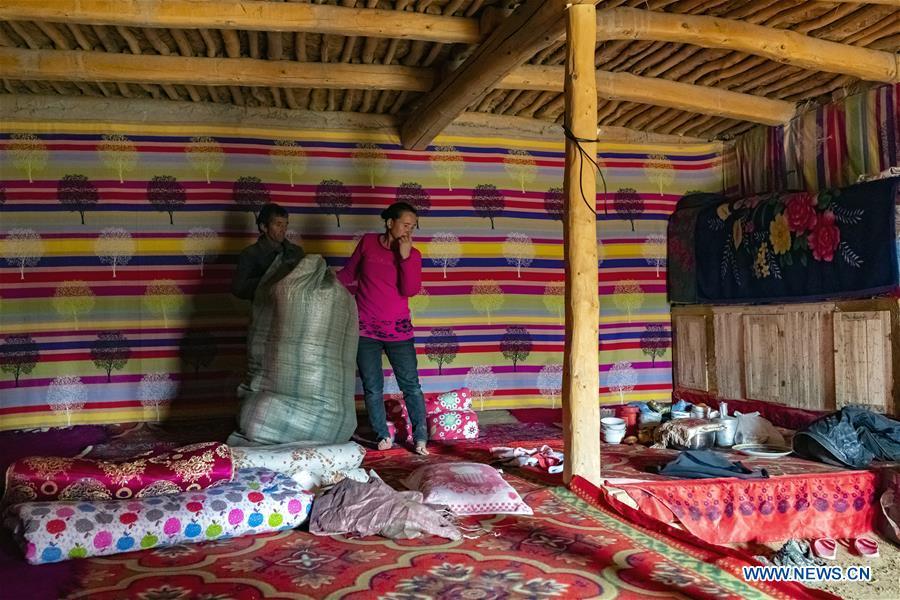
Imin and his wife prepare for moving to the relocation area for Darya Boyi Town in Yutian County, northwest China's Xinjiang Uygur Autonomous Region, Nov. 17, 2019. Before moving to the new settlement on Nov. 17 and Nov. 18 this year, sheep herder Imin's home was at the heart of the Taklimakan Desert, the second-largest shifting sand desert in the world. For hundreds of years, Imin's ancestors have settled along the Keriya River, which flows from south to north into the heart of endless sand dunes, branching out like fingers and providing the source of water for human habitats. Though the Keriya River has provided for the survival of Imin's ancestors, the environment has become less hospitable, with falling underground water level and frequent sand storms. A resettlement plan is underway to move the residents south to the edge of the desert, where better housing, drinking water facilities and roads are built. The Yutian County government, which administers the town, started to draft plans for resettlement in 2016. So far all of the 216 poverty-stricken households, including Imin's family, have moved into the new settlement, about 110 km from the old town. (Xinhua/Shen Bohan)
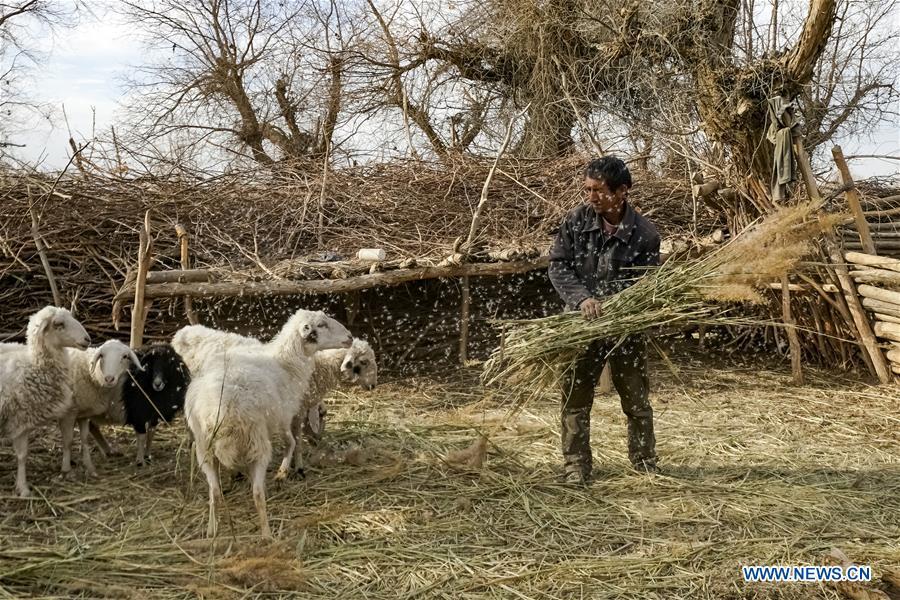
Imin feeds the sheep in Darya Boyi Town in Yutian County, northwest China's Xinjiang Uygur Autonomous Region, Nov. 15, 2019. Before moving to the new settlement on Nov. 17 and Nov. 18 this year, sheep herder Imin's home was at the heart of the Taklimakan Desert, the second-largest shifting sand desert in the world. For hundreds of years, Imin's ancestors have settled along the Keriya River, which flows from south to north into the heart of endless sand dunes, branching out like fingers and providing the source of water for human habitats. Though the Keriya River has provided for the survival of Imin's ancestors, the environment has become less hospitable, with falling underground water level and frequent sand storms. A resettlement plan is underway to move the residents south to the edge of the desert, where better housing, drinking water facilities and roads are built. The Yutian County government, which administers the town, started to draft plans for resettlement in 2016. So far all of the 216 poverty-stricken households, including Imin's family, have moved into the new settlement, about 110 km from the old town. (Xinhua/Shen Bohan)
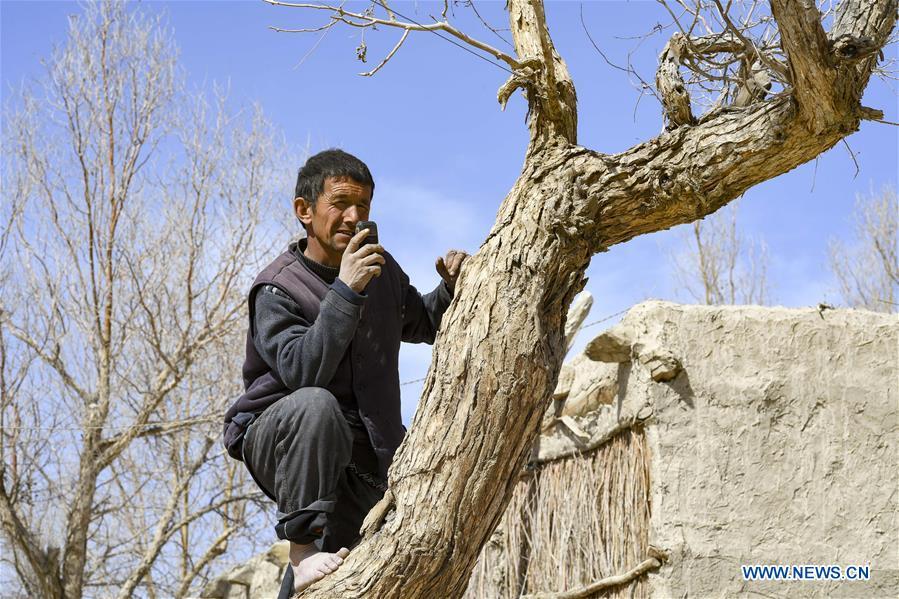
Imin climbs on a tree for better phone reception in Darya Boyi Town in Yutian County, northwest China's Xinjiang Uygur Autonomous Region, March 17, 2019. Before moving to the new settlement on Nov. 17 and Nov. 18 this year, sheep herder Imin's home was at the heart of the Taklimakan Desert, the second-largest shifting sand desert in the world. For hundreds of years, Imin's ancestors have settled along the Keriya River, which flows from south to north into the heart of endless sand dunes, branching out like fingers and providing the source of water for human habitats. Though the Keriya River has provided for the survival of Imin's ancestors, the environment has become less hospitable, with falling underground water level and frequent sand storms. A resettlement plan is underway to move the residents south to the edge of the desert, where better housing, drinking water facilities and roads are built. The Yutian County government, which administers the town, started to draft plans for resettlement in 2016. So far all of the 216 poverty-stricken households, including Imin's family, have moved into the new settlement, about 110 km from the old town. (Xinhua/Hu Huhu)
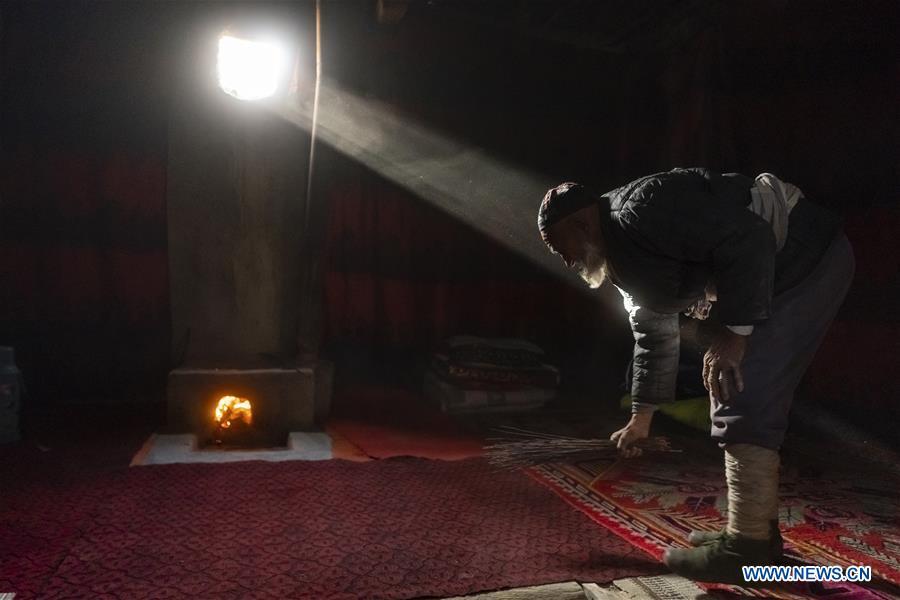
Imin's father cleans the old house in Darya Boyi Town in Yutian County, northwest China's Xinjiang Uygur Autonomous Region, Nov. 16, 2019. Before moving to the new settlement on Nov. 17 and Nov. 18 this year, sheep herder Imin's home was at the heart of the Taklimakan Desert, the second-largest shifting sand desert in the world. For hundreds of years, Imin's ancestors have settled along the Keriya River, which flows from south to north into the heart of endless sand dunes, branching out like fingers and providing the source of water for human habitats. Though the Keriya River has provided for the survival of Imin's ancestors, the environment has become less hospitable, with falling underground water level and frequent sand storms. A resettlement plan is underway to move the residents south to the edge of the desert, where better housing, drinking water facilities and roads are built. The Yutian County government, which administers the town, started to draft plans for resettlement in 2016. So far all of the 216 poverty-stricken households, including Imin's family, have moved into the new settlement, about 110 km from the old town. (Xinhua/Shen Bohan)
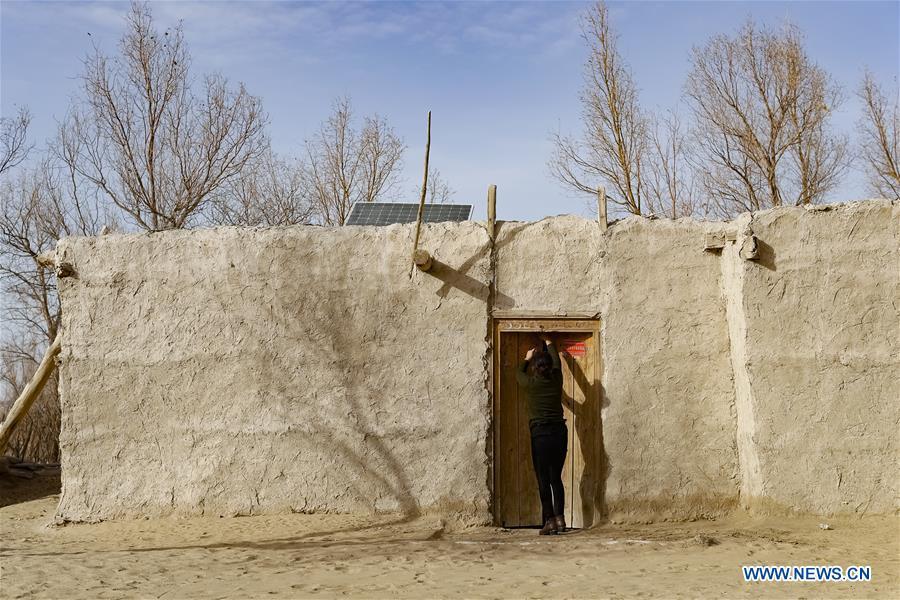
Imin's wife leaves their old home in Darya Boyi Town in Yutian County, northwest China's Xinjiang Uygur Autonomous Region, Nov. 17, 2019. Before moving to the new settlement on Nov. 17 and Nov. 18 this year, sheep herder Imin's home was at the heart of the Taklimakan Desert, the second-largest shifting sand desert in the world. For hundreds of years, Imin's ancestors have settled along the Keriya River, which flows from south to north into the heart of endless sand dunes, branching out like fingers and providing the source of water for human habitats. Though the Keriya River has provided for the survival of Imin's ancestors, the environment has become less hospitable, with falling underground water level and frequent sand storms. A resettlement plan is underway to move the residents south to the edge of the desert, where better housing, drinking water facilities and roads are built. The Yutian County government, which administers the town, started to draft plans for resettlement in 2016. So far all of the 216 poverty-stricken households, including Imin's family, have moved into the new settlement, about 110 km from the old town. (Xinhua/Shen Bohan)
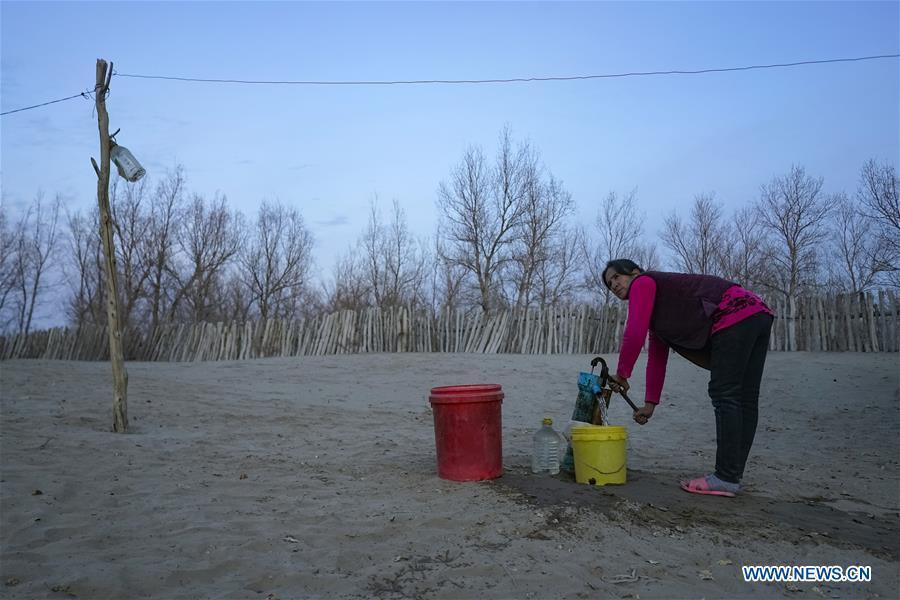
Imin's wife fetches water from a well at the old yard in Darya Boyi Town in Yutian County, northwest China's Xinjiang Uygur Autonomous Region, Nov. 16, 2019. Before moving to the new settlement on Nov. 17 and Nov. 18 this year, sheep herder Imin's home was at the heart of the Taklimakan Desert, the second-largest shifting sand desert in the world. For hundreds of years, Imin's ancestors have settled along the Keriya River, which flows from south to north into the heart of endless sand dunes, branching out like fingers and providing the source of water for human habitats. Though the Keriya River has provided for the survival of Imin's ancestors, the environment has become less hospitable, with falling underground water level and frequent sand storms. A resettlement plan is underway to move the residents south to the edge of the desert, where better housing, drinking water facilities and roads are built. The Yutian County government, which administers the town, started to draft plans for resettlement in 2016. So far all of the 216 poverty-stricken households, including Imin's family, have moved into the new settlement, about 110 km from the old town. (Xinhua/Shen Bohan)

Aerial photo taken on Nov. 16, 2019 shows Imin's old house at the Darya Boyi Town in Yutian County, northwest China's Xinjiang Uygur Autonomous Region. Before moving to the new settlement on Nov. 17 and Nov. 18 this year, sheep herder Imin's home was at the heart of the Taklimakan Desert, the second-largest shifting sand desert in the world. For hundreds of years, Imin's ancestors have settled along the Keriya River, which flows from south to north into the heart of endless sand dunes, branching out like fingers and providing the source of water for human habitats. Though the Keriya River has provided for the survival of Imin's ancestors, the environment has become less hospitable, with falling underground water level and frequent sand storms. A resettlement plan is underway to move the residents south to the edge of the desert, where better housing, drinking water facilities and roads are built. The Yutian County government, which administers the town, started to draft plans for resettlement in 2016. So far all of the 216 poverty-stricken households, including Imin's family, have moved into the new settlement, about 110 km from the old town. (Xinhua/Hu Huhu)













